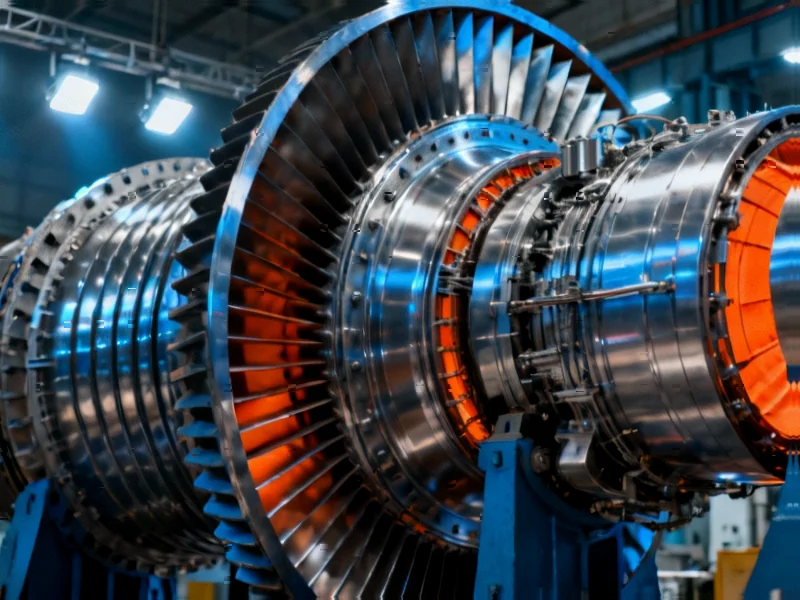The Unlikely Renaissance of Gas Turbines
In a dramatic reversal of fortune, gas turbine manufacturers are scrambling to meet unprecedented global demand after years of decline. What was once considered a dying industry has been resurrected by an unexpected source: the artificial intelligence revolution. The very technology positioned to transform our future is now fueling a massive return to fossil fuel infrastructure, creating a complex dilemma for climate goals and global energy security.
Table of Contents
- The Unlikely Renaissance of Gas Turbines
- From Obituary to Resurrection
- The AI Power Bottleneck
- Global Supply Chain Strain
- Environmental Consequences and Climate Goals
- Geopolitical Ramifications
- The Coal Conundrum
- Manufacturing Challenges and Strategic Shifts
- Long-term Outlook and Sustainability Questions
- Emerging Markets Left Behind
- Balancing Progress and Responsibility
From Obituary to Resurrection
Just three years ago, industry leaders were writing obituaries for gas turbines. Siemens Energy’s then North American president Rich Voorberg declared in 2022 that “gas turbines were dead” as renewable energy dominated the conversation. The company had cut 6,900 jobs in 2017, predicting demand would stabilize at just 110 large units annually against an industry capacity of 400. Today, that narrative has completely flipped. According to specialist energy consultancy Dora Partners, orders are forecast to reach 1,025 units this year, with 183 being large units—the highest since 2011 and a 50% increase over the previous five-year average.
The AI Power Bottleneck
The driving force behind this resurgence is the explosive growth of data centers required to power artificial intelligence systems. The U.S. Department of Energy forecasts that data centers will consume 6.7 to 12% of U.S. electricity by 2028, up from 4.4% in 2023. “The computing capacity required to scale up AI requires reliable, round-the-clock power,” explains an energy analyst familiar with the trend. This demand has rapidly positioned the United States as the global epicenter of new gas-fired power plant construction, with companies like Entergy building multiple plants specifically tied to massive data center campuses like Meta’s Hyperion facility in Louisiana.
Global Supply Chain Strain
The three manufacturers controlling approximately two-thirds of global gas turbine supply—Japan’s Mitsubishi Heavy Industries, Germany’s Siemens, and America’s GE Vernova—are struggling to keep pace. Customers now face wait times of three to five years for new turbines, creating a seller’s market not seen since the early 2000s. Yasuhiro Fujita, a 39-year veteran of MHI, acknowledges the challenge: “There’s so much demand right now that we can’t meet it all. I feel this boom is a big one because it’s worldwide.”
Environmental Consequences and Climate Goals
This sudden surge in gas turbine demand creates significant tension with global climate commitments. Climate activists note that the rush to gas power appears wildly out of sync with the Paris Agreement’s goal of limiting global warming to well below 2°C. While manufacturers are developing turbines capable of combusting hydrogen for zero-emission power, the availability of clean hydrogen fuel remains uncertain. The immediate consequence is a potential setback for decarbonization efforts, particularly as the focus shifts from climate goals to energy security and affordability., as comprehensive coverage, according to emerging trends
Geopolitical Ramifications
The turbine shortage extends beyond environmental concerns to international relations and development. Asian nations, long touted as the next growth market for liquefied natural gas, now face potential infrastructure delays that could last years. Raghav Mathur, a gas analyst at Wood Mackenzie, observes: “Nobody foresaw the U.S. coming in like this for the turbines. Even if Asian utilities want to place an order, they have to wait four or five years.” This bottleneck threatens to deny the U.S. and Japan a strategic tool for regional influence—supplying technology that China has yet to master.
The Coal Conundrum
Perhaps the most concerning unintended consequence involves coal power. With gas turbines unavailable and grid infrastructure inadequate for renewables, developing Asian nations may have no choice but to turn to coal plants—often using Chinese technology—to meet rising electricity demand. Takao Tsukui, president of Mitsubishi Power, notes the dramatic shift in conversation: “At the Asian power industry’s annual conference in Bangkok in 2022, it was almost like a sin to talk about coal. But today, the atmosphere of ‘energy transition, energy transition and no more fossil fuels’ has changed.”
Manufacturing Challenges and Strategic Shifts
The industry faces significant hurdles in scaling production. Manufacturers are pursuing modernization and automation rather than building new facilities to avoid stranded assets. MHI aims to double production within two years, but faces competition for suppliers from the booming aerospace and defense sectors. The market has become so tight that manufacturers are demanding deposits to reserve production slots—a practice last seen during the early 2000s boom—and charging premiums for earlier deliveries. GE Vernova reports being largely sold out for 2026 and 2027, with discussions now extending to 2030 deliveries.
Long-term Outlook and Sustainability Questions
Industry leaders express confidence in the longevity of this demand cycle. Tsukui predicts high demand for five to ten years “at least” due to AI’s power requirements, noting this boom differs fundamentally from previous cycles because it’s driven by tangible demand from data centers rather than market speculation. However, not all observers share this optimism. Anne-Sophie Corbeau, a gas specialist at Columbia University’s Center on Global Energy Policy, raises critical questions: “The big question for me is whether this is something which is going to be sustained or like a soufflé. People are starting to wonder if there’s an AI bubble.”
Emerging Markets Left Behind
As manufacturers prioritize U.S. AI demand, emerging markets face exclusion from the gas power expansion. Southeast Asian nations that postponed LNG decisions during the 2022 price surge now confront limited infrastructure availability and soaring costs. Sam Reynolds of the Institute for Energy Economics and Financial Analysis notes: “The LNG-to-power industry in Southeast Asia has faced many, many years of hurdles related to financing. And I would put this gas turbine shortage as the cherry on top.” Vietnam and the Philippines, which made significant bets on LNG, will likely miss their development targets, with Vietnam projected to fall dramatically short of its 2030 goal of 22.5GW LNG-fired capacity from the current 1.6GW.
Balancing Progress and Responsibility
The gas turbine shortage represents a critical inflection point in global energy policy. As AI development accelerates, the industry must navigate between meeting immediate power demands and maintaining progress toward climate goals. The solutions will require innovative approaches to energy efficiency, grid modernization, and potentially rethinking the relationship between technological advancement and environmental responsibility. How this balance is struck will determine not only the trajectory of AI development but also the world’s ability to meet its climate commitments in the coming decades.
Related Articles You May Find Interesting
- The Genetic Paradox: How Obesity Mutations May Shield Heart Health
- Tech Leaders and Public Figures Urge Halt to Advanced AI Development Over Safety
- Woodside Energy Boosts Production Outlook Despite Quarterly Revenue Decline
- Geopolitical Tensions Escalate as U.S. and China Vie for Influence in Argentina’
- UK Set to End Tax Advantage for Online Retailers in Budget Overhaul
This article aggregates information from publicly available sources. All trademarks and copyrights belong to their respective owners.
Note: Featured image is for illustrative purposes only and does not represent any specific product, service, or entity mentioned in this article.



